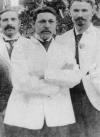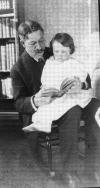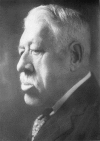The Hospital for the Ruptured and Crippled: William Bradley Coley, third Surgeon-in-Chief 1925-1933
- PMID: 18751855
- PMCID: PMC2504278
- DOI: 10.1007/s11420-007-9063-2
The Hospital for the Ruptured and Crippled: William Bradley Coley, third Surgeon-in-Chief 1925-1933
Abstract
In January 1925, the Board of Managers of the New York Society for the Relief of the Ruptured and Crippled appointed William Bradley Coley, M.D., age 63, Surgeon-in-Chief of the Hospital for the Ruptured and Crippled (R & C) to succeed Virgil P. Gibney who submitted his resignation the month before. It would be the first time a general surgeon held that position at the oldest orthopedic hospital in the nation, now known as Hospital for Special Surgery (HSS). Coley had been on staff for 36 years and was world famous for introducing use of toxins to treat malignant tumors, particularly sarcomas. A graduate of Yale College and Harvard Medical College, Coley interned at New York Hospital and was appointed, soon after, to the staff of the New York Cancer Hospital (now Memorial Sloan Kettering Cancer Center) located at that time at 106th Street on the West Side of New York. With his mentor Dr. William Bull, Coley perfected the surgical treatment of hernias at R & C. He was instrumental in raising funds for his alma maters, Yale, Harvard and Memorial Hospital. His crusade in immunology as a method of treatment for malignant tumors later fell out of acceptance in the medical establishment. After his death in 1936, an attempt to revive interest in use of immunotherapy for inoperable malignancies was carried out by his daughter, Helen Coley Nauts, who pursued this objective until her death at age 93 in 2000. Coley's health deteriorated in his later years, and in 1933, he resigned as chief of Bone Tumors at Memorial Hospital and Surgeon-in-Chief at R & C, being succeeded at Ruptured and Crippled as Surgeon-in-Chief by Dr. Eugene H. Pool. William Bradley Coley died of intestinal infarction in 1936 and was buried in Sharon, Connecticut.
Figures




References
-
- {'text': '', 'ref_index': 1, 'ids': [{'type': 'DOI', 'value': '10.1007/s11420-005-0116-0', 'is_inner': False, 'url': 'https://doi.org/10.1007/s11420-005-0116-0'}, {'type': 'PMC', 'value': 'PMC2504132', 'is_inner': False, 'url': 'https://pmc.ncbi.nlm.nih.gov/articles/PMC2504132/'}, {'type': 'PubMed', 'value': '18751802', 'is_inner': True, 'url': 'https://pubmed.ncbi.nlm.nih.gov/18751802/'}]}
- Levine DB (2005) Hospital for Special Surgery: origin and early history. HSS J 1:3–8 - PMC - PubMed
-
- {'text': '', 'ref_index': 1, 'ids': [{'type': 'DOI', 'value': '10.1007/s11420-005-0138-7', 'is_inner': False, 'url': 'https://doi.org/10.1007/s11420-005-0138-7'}, {'type': 'PMC', 'value': 'PMC2504108', 'is_inner': False, 'url': 'https://pmc.ncbi.nlm.nih.gov/articles/PMC2504108/'}, {'type': 'PubMed', 'value': '18751838', 'is_inner': True, 'url': 'https://pubmed.ncbi.nlm.nih.gov/18751838/'}]}
- Levine DB (2006) The Hospital for the Ruptured and Crippled: Knight to Gibney. 1870–1887. HSS J 2:1–6 - PMC - PubMed
-
- None
- Gibney RA (1969) Gibney of the Ruptured and Crippled. In: Shands AR Jr (ed) Meredith Corporation, New York
-
- Anonymous (1927) News notes, Virgil Pendleton Gibney. J Bone Jt Surg Am 9:781
-
- {'text': '', 'ref_index': 1, 'ids': [{'type': 'DOI', 'value': '10.1007/s11420-006-9008-1', 'is_inner': False, 'url': 'https://doi.org/10.1007/s11420-006-9008-1'}, {'type': 'PMC', 'value': 'PMC2488170', 'is_inner': False, 'url': 'https://pmc.ncbi.nlm.nih.gov/articles/PMC2488170/'}, {'type': 'PubMed', 'value': '18751820', 'is_inner': True, 'url': 'https://pubmed.ncbi.nlm.nih.gov/18751820/'}]}
- Levine DB (2006) Gibney as surgeon-in-chief: the earlier years, 1887–1900. HSS J 2:95–101 - PMC - PubMed
LinkOut - more resources
Full Text Sources

